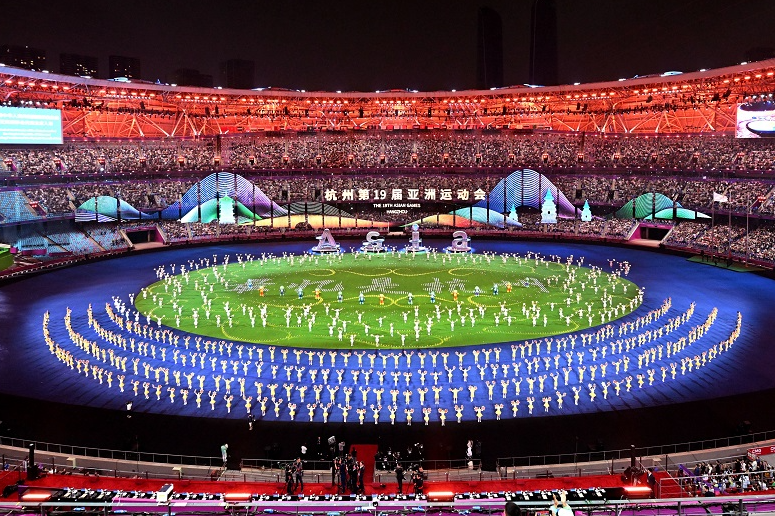Imagine standing in a packed stadium, watching a concert where the stage transforms into a swirling galaxy, or walking through Times Square dazzled by billboards that mimic real-life motion. These breathtaking visual experiences owe their magic to one unsung hero: RGB LED technology. At the heart of every vibrant full-color LED display lies this ingenious system of red, green, and blue light-emitting diodes working in perfect harmony. But how exactly do these tiny components create the kaleidoscope of colors we see? Let’s dive into the science, mechanics, and innovation behind RGB LEDs and their critical role in modern display systems.

Large format full color LED displays play very important roles in large events.
What is a Full Color LED Display?
A full color LED display is a dynamic visual system capable of reproducing 16.7 million colors – the entire spectrum visible to the human eye. Unlike monochrome or dual-color displays, these advanced screens combine three primary colored LEDs (red, green, and blue) in each pixel to achieve true-to-life imagery. From massive outdoor billboards to smartphone screens, full color LED displays dominate modern visual technology due to their:
- High brightness (up to 10,000 nits for outdoor use)
- Wide viewing angles (140°-160°)
- Energy efficiency compared to traditional lighting
- Scalability from micro-displays to stadium-sized installations
The Building Block: Understanding RGB LEDs
What is an RGB LED?
An RGB LED is a single package containing three micro-LED chips:
- Red(620-750nm wavelength)
- Green(495-570nm)
- Blue(450-495nm)
By controlling the intensity of each color channel through pulse-width modulation (PWM), these LEDs can mix light additively to create any hue. For instance:
- Red + Green = Yellow
- Green + Blue = Cyan
- Red + Blue = Magenta
- All three at full intensity = White
Types of RGB LEDs
1. Common Anode/Cathode LEDs
Common Anode: Shared positive terminal (easier for microcontroller control)
Common Cathode: Shared ground terminal (lower power consumption)
2. Package Formats
| Type |
Size |
Application |
Advantage |
| PLCC-4 |
3.5×2.8mm |
Indoor displays |
High density mounting |
| SMD 5050 |
5.0×5.0mm |
Consumer electronics |
Brightness & durability |
| COB (Chip-on-Board) |
Varies |
High-end video walls |
Seamless pixel blending |
3. Addressable LEDs
- NeoPixel (WS2812B)
- APA102 (DotStar)
- Allow individual pixel control via data protocols

Kinglight provides top quality SMD RGB LEDs
How RGB LEDs Work: The Science of Color Mixing
1. Additive Color Theory
Unlike subtractive color mixing (used in printing), RGB LEDs use additive principles where:
- Red + Green + Blue = White Light
- Absence of all colors = Black
- Partial combinations create secondary/tertiary hues
2. PWM Dimming Control
Each color channel’s brightness is regulated through:
- Pulse Width Modulation: Rapidly switching LEDs on/off (up to 1kHz frequency)
- 8-bit control: 256 intensity levels per channel (256³ = 16.7M colors)
- 12-bit/16-bit systems: Professional displays for smoother gradients
3. Color Calibration
Advanced displays employ:
- Gamma correction: Compensates for human eye’s non-linear brightness perception
- CIE 1931 color space mapping: Ensures accurate color representation
- Automatic white balance: Maintains consistency across temperatures
Advantages of RGB LED Technology
1. Color Performance
- 100-150% NTSC color gamut vs 72% for LCDs
- Deep blacks (infinite contrast ratio with OLED)
2. Energy Efficiency
- 40-60% less power than CCFL backlights
- Directional light emission reduces waste
3. Design Flexibility
- Bendable substrates for curved displays
- Pixel pitches from 0.7mm (indoor) to 10mm (outdoor)
4. Longevity
- 50,000-100,000 hour lifespan
- Minimal color degradation (<10% over 10 years)
Challenges & Limitations
1. Technical Complexities
- Color uniformity: Requires binning LEDs by wavelength
- Heat management: 20-30% energy lost as heat in high-brightness applications
- Moiré patterns: Pixel arrangement conflicts with camera sensors
2. Economic Factors
- 30-50% higher initial cost than monochrome LEDs
- Complex drivers/controllers increase system price
3. Environmental Impact
- Blue LEDs use rare-earth phosphors
- Recycling challenges from mixed-material construction
The Symbiosis: How RGB LEDs Enable Full Color Displays
1. Pixel Architecture
Modern LED walls use three configurations:
| Configuration |
LEDs per Pixel |
Use Case |
| Tri-chip SMD |
3 |
Fine-pitch indoor |
| Dual-chip w/ phosphor |
2 (Blue+Red + Green phosphor) |
Cost-sensitive |
| Four-color RGBA |
4 (Adds Amber) |
Enhanced color accuracy |
2. Driving Technologies
- Constant Current Reduction (CCR): Maintains brightness consistency
- HDR Implementation: 1000-4000 nits peak brightness
- Local Dimming: Up to 10,000 zones in premium TVs
3. Cutting-Edge Innovations
- MicroLED: <100µm chips for 8K+ resolution
- Quantum Dot Enhancement: 20% wider color gamut
- Transparent OLED-RGB Hybrids: 45% light transmittance
Future Trends in RGB LED Displays
- Mini/MicroLED Adoption
Samsung’s The Wall uses 0.8mm pitch microLEDs for cinema-quality home theaters.
- Smart Pixel Technology
TI’s DLP® Pico™ chips enable self-calibrating LED pixels.
- Eco-Friendly Developments
Researchers at MIT developed cadmium-free quantum dot LEDs in 2023.
- AR/VR Integration
Apple Vision Pro employs RGB OLEDoS with 3,500 PPI density.
Conclusion: Lighting the Path to Visual Revolution
From the glowing screens in our pockets to the skyscraper-sized displays reshaping urban landscapes, RGB LED technology has fundamentally transformed how we experience visual information. By mastering the delicate balance of red, green, and blue light, engineers have unlocked a world where digital displays rival – and sometimes surpass – the richness of natural vision. As innovations like microLED and quantum dots push the boundaries further, one truth remains: the future of visual technology will always return to those three primary colors that started it all.

